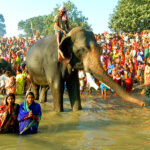The Sri Venkateswara Temple is truly captivating, blending divine spirituality with breathtaking architecture that leaves one in awe. My first visit to this sacred place in Tirupati was a mesmerising experience. Situated atop the Tirumala hills, the temple, with its pure beauty, is a must-visit that deserves a place on your bucket list.”
Location
The Sri Venkateswara Temple is located atop the Tirumala hills in Tirupati, India
History
The foundation stone for the Tirupati temple was laid in the 8th century by a Tamil ruler. Over the centuries, various rulers from different dynasties continued its development from the 9th to the 15th century. King Krishnadeveraya of Vijayanagar adorned the temple with a thin gold-plated cover and embedded jewels on its Vimanam.
Following the decline of Hindu rule, the temple was overseen by Muslim Karnataka rulers and later by British rulers. In 1932, an NGO named Tirumala Tirupati Devasthanam (TTD) assumed responsibility for the temple’s administration, managing activities such as maintenance, pilgrim darshans, pujas, and celebrations.
Architecture

The temple, built in the Dravidian architectural style, features three entrances leading to the main shrine, Ananda Nilayam. The primary entrance, Mahadwara Gopuram, is adorned with brass doors. Two circumambulation paths exist: one housing sub-shrines, the central kitchen, and the main hundi, while the other includes pillared halls, flagstaffs, and an area for offerings.
Ananda Nilayam, a gold-plated tower within the main shrine, houses the principal deity dating back to the 12th century A.D. Swami Pushkarini, a revered water body north of the temple, spans 1.5 acres and is said to have been carried by Garuda from Lord Vishnu’s home. King Narasimha Raya built a hall with pillars in the pond’s center in 1468.
The Sri Venkateswara Temple in Tirumala boasts multiple entrances, each with a distinct name and significance.
About deities
Lord Venkateswara, often known as Tirupati Balaji, is considered an incarnation of Lord Vishnu, a prominent deity in Hinduism. The temple venerates him as the presiding deity, represented by the main deity (moolavirat) and four other deities collectively known as Pancha Beramulu. Alongside Lord Venkateswara, the temple houses idols of Krishna, Rukmini, Chakrathalwar, Rama, Sita, Lakshmana, Hanuman, Vishwaksena, Sugriva, Angada, and Salagramulu.
Garuda Seva
The Garuda Seva, a pivotal event at the Sri Venkateswara Temple in Tirumala, is an annual procession where Lord Venkateswara’s idol is placed on a chariot, pulled by devotees around the temple complex. This grand spectacle marks the end of the nine-day Brahmotsavam festival in October, signifying gratitude to Garuda for fetching medicinal plants for Lord Venkateswara’s wedding.
Devotees consider witnessing Garuda Seva a life-changing experience, attracting thousands worldwide. The event, concluding the Brahmotsavam, is believed to bestow good fortune and spiritual merit upon observers. The best time to visit Tirupati is from September to February, offering pleasant weather for exploring the town and the temple, with temperatures ranging from 15°C to 30°C.
Some special facts
Although the idol of Lord Tirupati Balaji appears to stand in the centre of the sanctum sanctorum, it is technically placed in the right-hand corner of the shrine—a fascinating legend.
Lord Balaji’s silky, smooth, and tangle-free hair is real. A Gandharva Princess named Neela Devi cut a portion of her mane to replace Lord Balaji’s lost hair, a tradition continued by devotees who shave their heads at the temple.
The unchangeable truth is that the sound of enormous sea waves can be heard by placing one’s ear on the back of the deity’s image housed in the shrine.
The light of an ardent devotee’s heart for the Divine never extinguishes, much like the earthen lamps placed before the idol in the sanctum sanctorum of the Tirupati Balaji Temple.
For an inexplicable reason, the back of the idol always remains moist, despite efforts by priests to keep it dry.
Flowers offered to Lord Balaji during morning worship are not thrown out of the GarbhaGudi. Instead, they are thrown into waterfalls behind the rear side of the idol, ending up 20 kilometres away in Yerpedu.
Despite scientific knowledge that camphor causes cracks in stone, the idol of Shri Tirupati Balaji is resistant to camphor’s chemical reactions, bearing no marks.
Lord Balaji’s stone-carved image is said to be infused with life, maintaining a temperature of 110 degrees Fahrenheit, even in the cool surroundings of the temple’s elevated location (3000 feet).
How to reach?
To reach the Sri Venkateswara Temple in Tirupati:
By Air: The nearest airport is Tirupati Airport (Renigunta), and from there, you can hire a taxi or take public transportation to reach the temple.
By Train: Tirupati Railway Station is well-connected, and you can take a train to reach there. From the station, you can hire a taxi or use local transportation.
By Road: Tirupati has good road connectivity. You can either drive or take a bus to Tirupati and then proceed to the temple. Regular buses and taxis are available.
On Foot: Pilgrims often choose to climb the steps leading to the temple from Tirupati town. It’s a traditional and popular way to approach the sacred site.
Ensure to check the current transportation options and routes for the most accurate information.
Final thoughts
The legends, architecture, and overall structure associated with this temple elevate it to the status of one of the most significant in the world. Local tales come to life when witnessed firsthand, and the deity’s presence feels so authentic that one can’t help but become immersed in devotion.”











